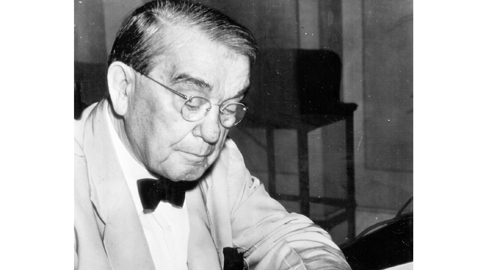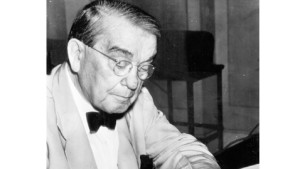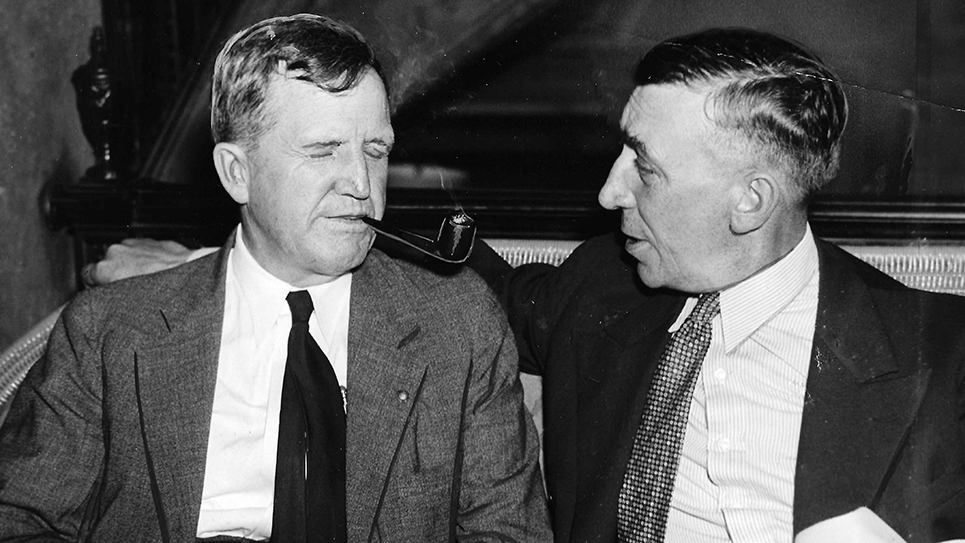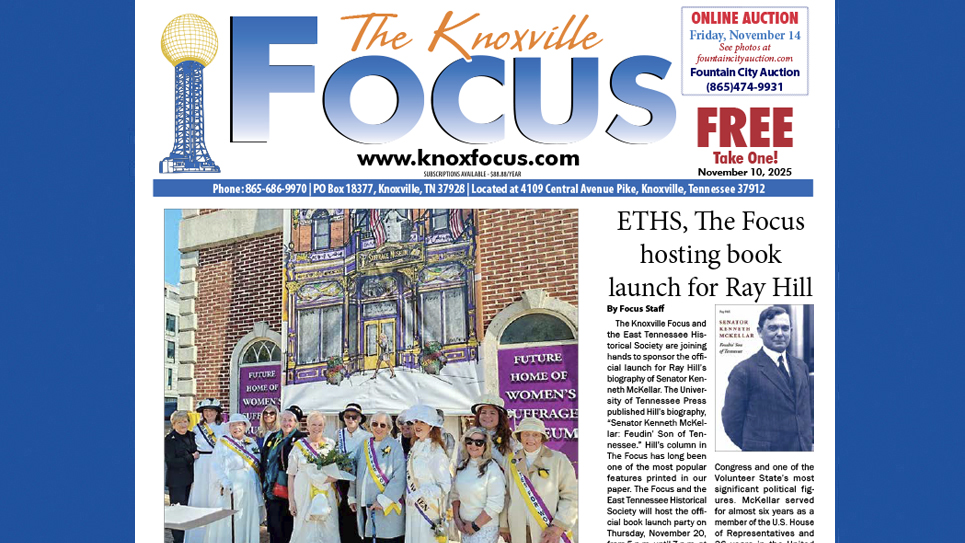Kenneth Douglas McKellar arrived in the United States Senate in 1917 and it was a much sleepier place than it would become a few decades later.
Capitol Hill has always been almost a world unto itself through the ages and still is; the Senate had its own post office, barber shop, private store, stationery shop, gymnasium and restaurants. The Senate had its own cabinet shop, where furniture was made and the photographs senators wished to be displayed would be sent down for framing. An elaborate maze of underground tunnels connected the various office buildings to the Capitol, complete with a miniature subway to deliver senators to Capitol Hill quickly.
Mail was delivered twice daily to senatorial offices and there were chutes at the end of the hall where employees could deposit letters, which descended into the bowels of the Russell Senate Office Building.
Considering the number of employees and visitors to Capitol Hill, folks naturally had to be fed. There was a restaurant open to the public, as well as one exclusively for the use of members of the Senate. A new menu was printed daily for visitors to order lunch. A sample menu from 1940 indicates one could order a lunch of flanked tenderloin steak with mushrooms for 85 cents; while an entire Maine lobster with julienne potatoes and combination salad was also 85 cents. For 60 cents, one could dine on broiled rockfish, string beans, and browned potatoes. A glass of milk was 5 cents and a pot of coffee was 15 cents.
Before 1909, senators had no official office, with many members using personal funds to rent office space in Washington. Realizing the need for offices and committee rooms, the first Senate Office Building was built in 1909. Two others would pop up over the years with the “old” Senate office building being named for Georgia U. S. Senator Richard Russell. The “new” Senate office building, completed in 1958, would be named for Illinois Senator Everett Dirksen and the most modern of all, the Hart Senate Office Building (named for Michigan Senator Philip Hart) was built in 1982. The Russell Building featured beautiful and ornate chandeliers, fireplaces in the private offices of senators, and none of the later buildings bespeaks the rich wood and elegance of the Russell Senate Office Building. Senator McKellar’s office was a prime suite of rooms on the second floor of the Russell Senate Office Building, a suite later occupied by now-Vice President Joe Biden.
When the Senate Office Building was new in 1909, each senator had a suite consisting of two rooms and there was a private lavatory for the senator.
Richard Riedel spent almost fifty years as an employee of the United States Senate and wrote a fascinating memoir entitled Halls of the Mighty, detailing his experiences. Mr. Riedel gave an account not only of his observations of individual members of the Senate, but provided much color about the institution of the Senate.
In the Senate cloakroom, there were a series of wooden lockers, with each senator’s name emblazoned in carefully hand-painted gold letters where he could hang his coat and hat before proceeding to the Senate floor. The Senate barbershop, at a time before disposal razors, much less electric razors, contained a collection of beautiful porcelain mugs, rimmed in black and gold with each senator’s name on his personal shaving mug. Every senator was gifted with his own comb and hairbrush as well as an individualized shaving mug. The senator’s barbershop was operated only for those elected to the United States Senate, while another served the Senate employees. Members paid nothing for their haircuts, although most tipped the barbers who were on the Senate payroll.
Riedel was living in Washington, D. C. and was nine years old when he was selected to serve as a Pageboy in the United States Senate under the patronage of the powerful Pennsylvania Republican Boies Penrose. The Senate floor at the time featured elaborate snuff boxes for those members who wished to avail themselves. In today’s world, snuff is almost unheard of and largely forgotten. For those who are not familiar with this smokeless tobacco product, it is ground tobacco. One would take a pinch of snuff and inhale it, oftentimes producing a magnificent sneeze. The U. S. Senate in 1917 had snuffboxes located on either side of the Chamber, one for Democrats and another for Republicans. There were also cuspidors discreetly placed on the Senate floor for those senators who enjoyed chewing tobacco inside the Senate chamber.
When someone wished to see a senator who was on the floor, the guest would be escorted into the Senate Lobby or the ornate Marble Room and the senator could comfortably talk to his visitor while sitting on an overstuffed leather sofa. Senators, wishing for some peace and quiet, could retire to the Reading Room where newspapers from every state were kept and a huge map of the United States displaying current weather conditions hung on the wall. The Reading Room was yet another place exclusively for the use of senators and forbidden to anyone else.
For those members of the Senate who retained the favor of their constituents, came longevity in office, which brought increased power and prestige. Office space, like most everything else, was allocated on the basis of seniority. Junior senators were given office suites consisting of three rooms, while more senior senators occupied four room suites. Seniority also brought that particular senator more office space as well as one of the “hideaway” offices in the Capitol. The location of each senator’s hideaway office was carefully guarded and frequently even staff members did not know precisely where their own senator’s private office might be; the senator himself carried the key to unlock the door of his own hideaway. Depending upon the senator’s seniority, the room could be very simple, if not actually barren. For those lucky few who were senior members, the office could be positively sumptuous with grand chandeliers and beautiful furniture.
Lyndon Johnson was so acquisitive when he was Majority Leader of the U. S. Senate, he set a new senatorial standard and he soon occupied most of a wing of one Capitol Hill floor and his offices were so luxurious, they were referred to as the “Taj Mahal”.
Another benefit of seniority was the chairmanship of a committee; the more important the committee, the more staff positions and office space available to the senator. Kenneth McKellar eventually was the Senate’s most senior member, Chairman of the Appropriations Committee and President Pro Tempore of the United States Senate. McKellar had his office in the old Senate Office Building, the impressive ceremonial office of the President Pro Temp, a private office allotted to the Chairman of the Appropriations Committee, as well as one of the better hideaway offices inside the Capitol.
The Senate had its own library and if a particular book could not be found for a senator, the Library of Congress would send along the requested book via a small tunnel on a conveyor inside a small trunk that resembled a suitcase.
The beautiful President’s Room was the site of an altercation involving Senator McKellar and a member of the press who had angered the hot-tempered Tennessean. Richard Riedel, then serving as the Senate’s first press liaison, was approached by Bob Horton, a Scripps-Howard reporter who wished to see McKellar. Riedel, never suspecting anything amiss, dutifully went to fetch Senator McKellar from the Senate floor. McKellar entered the President’s Room to find Horton waiting for him and unbeknownst to the horrified Riedel, discovered the reporter had penned a story that had enraged McKellar. Senator McKellar grew increasingly agitated, berated the surprised reporter in typically colorful McKellar language. The old Senator was soon shaking his fists in Horton’s face as he recounted the reporter’s perfidy and finally worked himself into a state of real fury. When Riedel saw McKellar draw back his right arm to take a swing at the startled reporter, he jumped in between Horton and Senator McKellar, shouting, “Please!”
McKellar turned and stomped off to the Senate Chamber, while Horton breathed a sigh of relief. Neither McKellar nor Horton forgot the incident and according to Mr. Riedel, the two men never exchanged another word. McKellar did later thank Riedel for his intervention, saying he appreciated Riedel’s having prevented what would surely have been an embarrassing moment.
The President’s Room was so named due to the fact every chief executive from the time of Lincoln had visited Capitol Hill to sign bills before the adjournment of each Congress. A large table, padded with green felt, was used by the presidents to affix his signature to legislation, a custom that came to an end with the arrival of Franklin Delano Roosevelt. President Lyndon Johnson, a man with a sense of history and love for the Senate’s traditions, returned to the President’s Room to sign into law his historic Civil Rights Act of 1965. The table came to be known as the “Lincoln table” due to Abraham Lincoln having used it to sign legislation to free those slaves who had been pressed into service by the Confederate Army.
Richard Riedel related another incident inside the President’s Room involving Senator McKellar. The Senator was being interviewed by a reporter when Riedel was suddenly jolted by the sound of a tremendous crash and the sound of broken glass and he watched as a vast cloud of dust came billowing out of the room.
“Knowing Senator McKellar was in there, I wondered what he had done this time!” Riedel recalled.
The dust was apparently so thick one could not actually see what had occurred inside the President’s Room. Riedel watched as the occupants drifted out of the room and at least in this particular instance, McKellar was not the cause of the commotion. Evidently a plaster panel above a chandelier had fallen, taking with it much of a chandelier in its descent.
The pace of life in the Capitol was much quieter than it would be years later. Senators had very small staffs and there were no offices back home in their respective states, save for those professional offices maintained by the member, many of whom continued to practice law when Congress was not in session. Senator McKellar had largely closed his own law office, but kept an office in the Commerce Trust Building in Memphis where he received visitors and answered mail.
McKellar remained readily accessible to friends and constituents throughout the balance of his long Congressional career. My friend Hal Gerber is the son of Will Gerber, who was an attorney and close associate of Memphis Boss E. H. Crump. Young Hal was interested in an appointment to one of the military academies and his father took him to McKellar’s apartment in the Gayoso Hotel. Hal Gerber recalls receiving a warm welcome from the Senator who patiently explained his appointments to the various military academies were filled. McKellar offered to recommend Hal instead of one of the current applicants, but Hal thought the Senator knew he would not wish that and said so.
Washington, D. C. has been commonly referred to as something of a “sleepy Southern town” many times, but Congressional offices and the pace of life in the Capitol changed dramatically with the arrival of the New Deal and President Franklin D. Roosevelt. The economic crisis caused Congressmen and senators to be flooded with letters from constituents begging for some kind of job or help. World War II changed things even more, with Congress remaining in session for even longer periods of time.
A reorganization of the Congress came in 1946 with senators replacing their “Secretary” with an Administrative Assistant. Senators were given more professional staff and the antiquated committee structure was streamlined, giving new members at least one good assignment.
Today, despite the advances in technology, it seems the pace of life is faster in every respect. Communications to Members of Congress are usually sent via email and one may or may not receive a response, but in any event it seems far less personal. Replies are frequently mass generated and the signature is usually a computer font printed onto the page. The days of real orators holding the Senate floor are largely over; today Congressman and senators appear on the floor blow-dried and wearing the soft blue shirts conducive to making a good appearance on television. The passing of West Virginia Senator Robert C. Byrd, who entered the Senate in 1959, was the end of an era. The once revered traditions of the United States Senate are now largely confined to the pages of history and museum pieces, but what a tradition it was!








